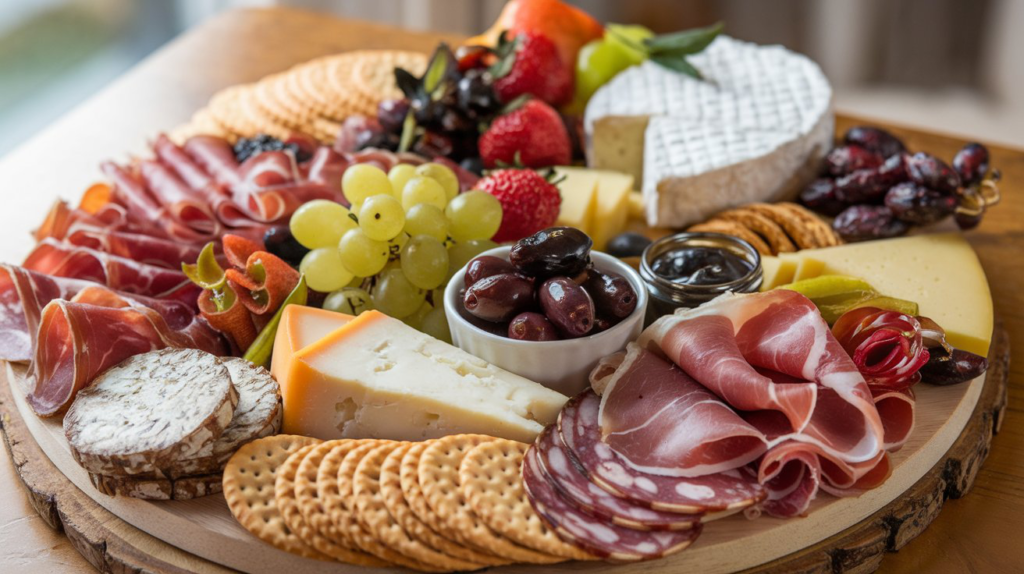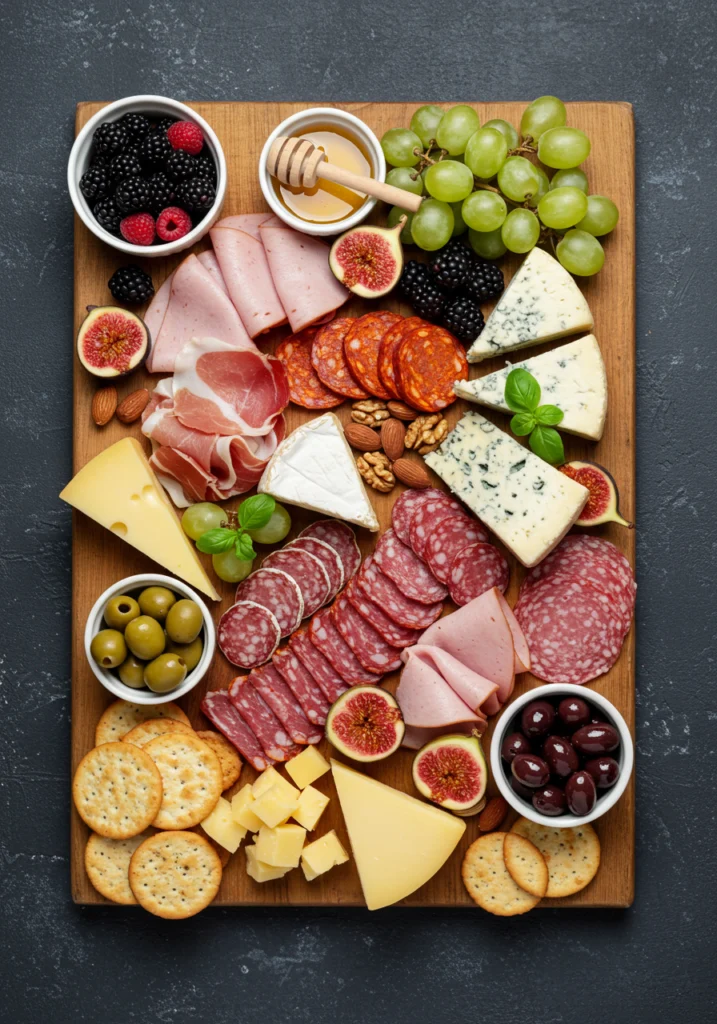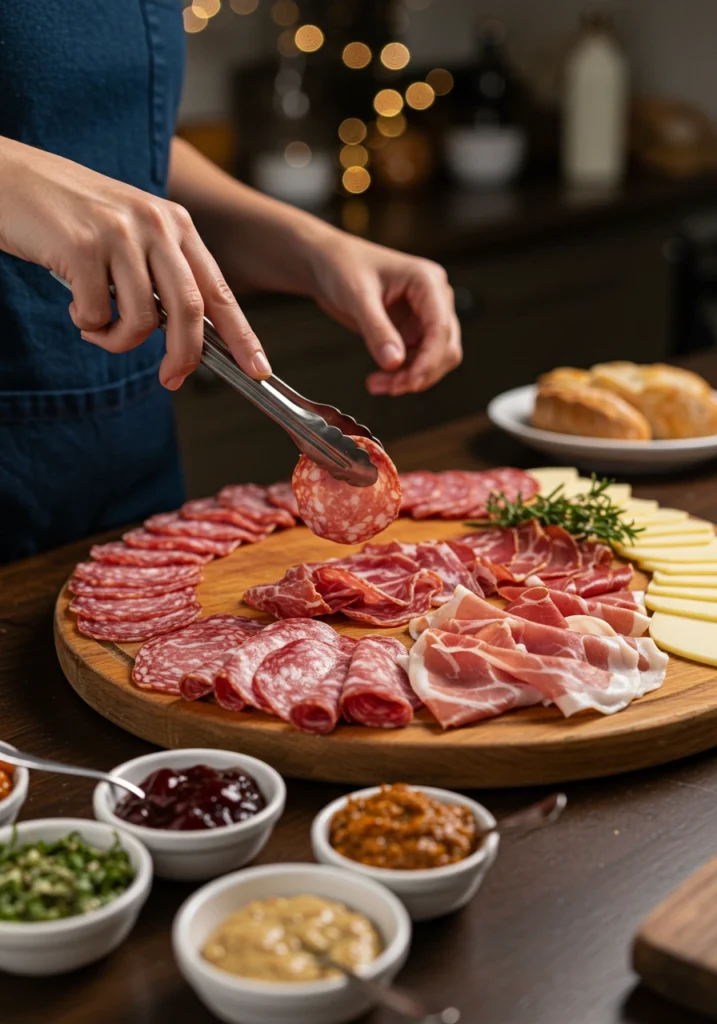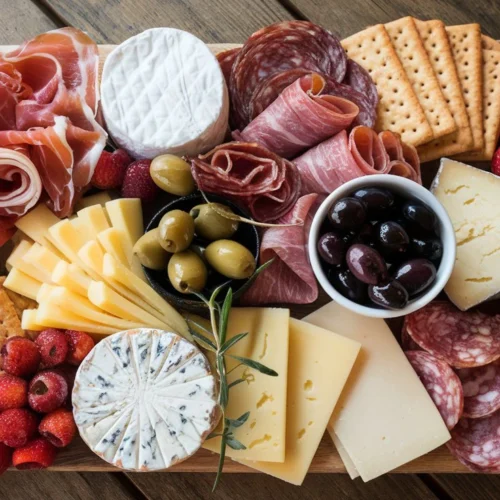Have you ever wondered what makes a charcuterie board the centerpiece of every party? There’s something truly magical about the combination of cured meats, artisanal cheeses, and gourmet snacks that transforms simple gatherings into memorable feasts. Charcuterie meats, with their rich flavors and versatility, are the heart of it all—perfect for everything from casual get-togethers to elegant celebrations.
In this guide, I’ll walk you through how to choose, prepare, and enjoy these delicious cured meats like a pro. Whether you’re new to charcuterie or looking to elevate your next platter, you’ll find plenty of tips, tricks, and inspiration to create a spread that wows your guests. Let’s dive in and unlock the secrets to mastering charcuterie meats!
Table of Contents
Key Benefits
Charcuterie meats are more than just a delicious addition to your table—they’re a game-changer for anyone who loves effortless entertaining. Here’s why they deserve a spot on your next menu:

- Unmatched Variety: From the smoky richness of salami to the delicate, melt-in-your-mouth texture of prosciutto, charcuterie meats offer a range of flavors to satisfy every palate.
- Versatility for Any Occasion: Whether it’s a cozy night in or a festive gathering, charcuterie meats adapt effortlessly. Pair them with cheese, fruits, or spreads for a show-stopping board.
- Convenient and Low-Prep: No time to cook? No problem. These ready-to-eat cured meats save you time while delivering gourmet-level taste.
- Perfect Protein Source: Packed with protein and rich in flavor, charcuterie meats are a satisfying option that balances indulgence with nourishment.
The beauty of charcuterie meats lies in their simplicity—they make you look like a pro without the stress. With a little creativity, you can craft a platter that’s as visually stunning as it is delicious.
Essential Ingredients
Creating the perfect charcuterie platter starts with choosing the right ingredients. A thoughtful selection ensures a balance of flavors, textures, and visual appeal. Here’s a handy list to guide you:

Essential Charcuterie Meats
- Salami: Go for dry-cured varieties like Genoa or soppressata for bold, savory notes.
- Prosciutto: Its delicate, buttery texture pairs beautifully with fruits or crusty bread.
- Chorizo: A slightly spicy option that adds a kick to your board.
- Mortadella: A smooth and creamy choice with a hint of garlic and spice.
- Capicola (Coppa): Offers a rich, smoky flavor that’s perfect for rounding out the selection.
Tasty Accompaniments
To complement the meats, include a mix of:
- Cheeses: Try brie, aged cheddar, gouda, or blue cheese for variety.
- Fresh Fruits: Grapes, figs, or sliced apples add a touch of sweetness.
- Crunchy Elements: Crackers, breadsticks, or toasted baguette slices are ideal for layering.
- Pickled Veggies: Add tang with pickles, olives, or marinated artichokes.
- Sweet Extras: A drizzle of honey, fig jam, or a handful of candied nuts ties it all together.
Pro Tip:
Aim for a balance of flavors—combine salty, sweet, tangy, and spicy elements to keep every bite exciting. Don’t forget to select ingredients that align with your theme or guests’ preferences, whether it’s classic Italian or a more adventurous global spread.
With these ingredients in hand, you’re ready to start assembling a board that’s as delicious as it is Instagram-worthy!
Instructions: How to Prepare Charcuterie Meats for Your Board
Assembling a charcuterie platter might seem intimidating, but it’s surprisingly simple—and so much fun! Follow these step-by-step instructions to create a visually stunning and delicious spread:

Step 1: Plan Your Board
Start with a clean, flat surface like a wooden cutting board, slate, or serving tray. Choose a size based on the number of guests—plan for about 2–3 ounces of charcuterie meats per person.
Step 2: Arrange the Meats
- Begin by placing your charcuterie meats in clusters around the board.
- Pro Tip: Fold thin slices like prosciutto and salami into rosettes or accordion shapes for added texture and visual interest.
- Include a mix of spicy, savory, and mild meats to cater to varied tastes.
Step 3: Add Cheeses
- Position the cheeses near the meats, leaving space for slicing if needed.
- Use a mix of hard, soft, and semi-soft cheeses for variety.
- Slice a portion of each cheese to make it easier for guests to dig in.
Step 4: Fill in with Accoutrements
- Add fresh fruits like grapes or sliced pears for pops of color and sweetness.
- Nestle small bowls of pickles, olives, or jams into empty spaces on the board.
- Scatter crackers, breadsticks, or crostini in between for a crunchy element.
Step 5: Finish with Garnishes
- Sprinkle candied nuts, fresh herbs, or edible flowers over the board for the final touch.
- Make sure every part of the board is accessible, ensuring no single flavor overpowers another.
Step 6: Serve and Enjoy
- Set out small plates, napkins, and serving utensils like cheese knives or tongs to make self-serving easy.
- Encourage your guests to mix and match flavors—there’s no wrong way to enjoy a charcuterie board!
With these simple steps, you’ll have a masterpiece ready to impress everyone. Don’t forget to snap a picture before it gets devoured!
Pro Tips and Variations for Charcuterie Meats
Want to take your charcuterie board to the next level? These pro tips and creative variations will help you craft a platter that’s as unique as it is delicious:
Pro Tips for Success
- Temperature Matters: Serve your charcuterie meats at room temperature to maximize their flavors. Take them out of the fridge about 30 minutes before assembling your board.
- Balance is Key: Include a mix of textures and flavors—combine creamy cheeses with crunchy crackers, salty meats with sweet fruits, and tangy pickles with mild spreads.
- Visual Appeal: Arrange ingredients with contrasting colors and shapes. Use round meats like salami, rectangular crackers, and triangular cheese wedges to create visual variety.
- Portion Wisely: For larger gatherings, consider creating multiple smaller boards to keep everything looking fresh and accessible throughout the event.
Creative Variations
- Themed Boards:
- Italian-Inspired: Focus on prosciutto, soppressata, mortadella, and parmesan, paired with marinated artichokes and balsamic glaze.
- French Flair: Highlight pâté, saucisson sec, brie, and camembert with cornichons and Dijon mustard.
- Global Fusion: Incorporate Spanish chorizo, German speck, and Asian-inspired cured duck with unique sauces like spicy plum chutney.
- Diet-Friendly Options:
- Keto-Friendly: Stick to low-carb accompaniments like olives, cheese crisps, and roasted nuts.
- Vegetarian Alternative: Replace meats with roasted vegetables, smoked tofu, and plant-based charcuterie.
- Seasonal Additions:
- In the summer, add fresh berries, melon slices, and citrus zest.
- During fall, use figs, spiced nuts, and pumpkin-infused spreads.
Pro Tip for Leftovers
If you have leftovers, repurpose them for sandwiches, salads, or even a pasta dish the next day. Charcuterie meats and cheeses make for effortless, next-day meals!
With these tips and variations, you can customize your charcuterie board for any occasion while wowing your guests with creativity and flair.
Serving Suggestions for Charcuterie Meats
Now that your charcuterie board is ready to shine, it’s time to think about how to serve it for maximum impact. Whether you’re hosting a casual get-together or an elegant dinner party, these serving suggestions will help elevate the experience:

1. Pair with Wine
A carefully selected wine can complement the flavors of your charcuterie meats and cheeses perfectly. Consider these classic pairings:
- Red Wines: Bold reds like Cabernet Sauvignon or Zinfandel pair wonderfully with savory meats like salami and prosciutto.
- White Wines: A crisp Chardonnay or Sauvignon Blanc works beautifully with milder cheeses and lighter meats like mortadella.
- Rosé or Sparkling Wines: If you want something versatile, go for a chilled rosé or bubbly like Prosecco. It’s refreshing and pairs well with a variety of flavors.
2. Use Small Plates and Tongs
For ease of serving, set out small plates and a few tongs or cheese knives for guests to help themselves. This allows everyone to pick their favorites without creating a mess or overcrowding the board.
3. Create a Build-Your-Own Experience
Let your guests have fun with the charcuterie experience! You can offer a “build-your-own” platter approach by arranging a variety of meats, cheeses, fruits, and spreads on the table, and letting everyone assemble their personal bites. This adds an interactive element that’s sure to spark conversation and creativity.
4. Garnish for a Personal Touch
Add a few finishing touches to make your platter look extra special. Fresh herbs like rosemary or thyme not only add a beautiful pop of color but also bring an aromatic touch. A drizzle of honey or fig jam over the meats or cheeses can provide a delightful contrast of sweetness to the savory flavors.
5. Keep It Accessible
Make sure your board is placed at a convenient height and in an easy-to-reach spot. If you’re serving a large crowd, consider placing the board on a low table where people can easily gather around and serve themselves.
6. Portion Wisely
Depending on the number of guests, you may need more than one charcuterie board. For larger gatherings, it’s a good idea to spread out the platters so that everyone can access the food without overcrowding one area.
With these serving suggestions, your charcuterie board will be the star of the show—inviting guests to savor every bite while enjoying the relaxed, social atmosphere. Whether you’re serving it as an appetizer or a main course, these thoughtful touches will ensure your board is a hit!
Conclusion
Congratulations! You’ve now mastered the art of assembling the perfect charcuterie board. With your thoughtful selection of charcuterie meats, cheeses, and accompaniments, you’ve created a spread that’s not only delicious but also visually stunning. Whether you’re serving it at a cozy family dinner or at a chic cocktail party, your charcuterie board will surely impress.
To recap, remember:
- Balance is everything: Mix savory meats with sweet fruits, rich cheeses with tangy spreads.
- Be creative: Don’t be afraid to try new meats, cheeses, and seasonal ingredients to keep things exciting.
- Have fun: Charcuterie is about sharing and enjoying the experience—let your guests build their own bites and explore new flavor combinations.
As you continue to experiment with charcuterie, keep these tips in mind and don’t be afraid to make it your own. It’s a simple yet luxurious way to entertain and add a gourmet touch to any occasion. Enjoy the process and, most importantly, the delicious results!
Now, grab your favorite charcuterie meats and get started on your next masterpiece. Happy entertaining!
______________

Charcuterie Meats
Ingredients
Essential Charcuterie Meats
- Salami: Go for dry-cured varieties like Genoa or soppressata for bold savory notes.
- Prosciutto: Its delicate buttery texture pairs beautifully with fruits or crusty bread.
- Chorizo: A slightly spicy option that adds a kick to your board.
- Mortadella: A smooth and creamy choice with a hint of garlic and spice.
- Capicola Coppa: Offers a rich, smoky flavor that’s perfect for rounding out the selection.
Tasty Accompaniments
- To complement the meats include a mix of:
- Cheeses: Try brie aged cheddar, gouda, or blue cheese for variety.
- Fresh Fruits: Grapes figs, or sliced apples add a touch of sweetness.
- Crunchy Elements: Crackers breadsticks, or toasted baguette slices are ideal for layering.
- Pickled Veggies: Add tang with pickles olives, or marinated artichokes.
- Sweet Extras: A drizzle of honey fig jam, or a handful of candied nuts ties it all together.
Pro Tip:
- Aim for a balance of flavors—combine salty sweet, tangy, and spicy elements to keep every bite exciting. Don’t forget to select ingredients that align with your theme or guests’ preferences, whether it’s classic Italian or a more adventurous global spread.
Instructions
Step 1: Plan Your Board
- Start with a clean, flat surface like a wooden cutting board, slate, or serving tray. Choose a size based on the number of guests—plan for about 2–3 ounces of charcuterie meats per person.
Step 2: Arrange the Meats
- Begin by placing your charcuterie meats in clusters around the board.
- Pro Tip: Fold thin slices like prosciutto and salami into rosettes or accordion shapes for added texture and visual interest.
- Include a mix of spicy, savory, and mild meats to cater to varied tastes.
Step 3: Add Cheeses
- Position the cheeses near the meats, leaving space for slicing if needed.
- Use a mix of hard, soft, and semi-soft cheeses for variety.
- Slice a portion of each cheese to make it easier for guests to dig in.
Step 4: Fill in with Accoutrements
- Add fresh fruits like grapes or sliced pears for pops of color and sweetness.
- Nestle small bowls of pickles, olives, or jams into empty spaces on the board.
- Scatter crackers, breadsticks, or crostini in between for a crunchy element.
Step 5: Finish with Garnishes
- Sprinkle candied nuts, fresh herbs, or edible flowers over the board for the final touch.
- Make sure every part of the board is accessible, ensuring no single flavor overpowers another.
Step 6: Serve and Enjoy
- Set out small plates, napkins, and serving utensils like cheese knives or tongs to make self-serving easy.
- Encourage your guests to mix and match flavors—there’s no wrong way to enjoy a charcuterie board!
- With these simple steps, you’ll have a masterpiece ready to impress everyone. Don’t forget to snap a picture before it gets devoured!
Notes
- Calories: 250
- Fat: 18g
- Saturated Fat: 7g
- Trans Fat: 0g
- Protein: 12g
- Carbohydrates: 10g
- Fiber: 2g
- Sugars: 3g
- Cholesterol: 25mg
- Sodium: 500mg
- Potassium: 150mg
- Vitamin A: 6%
- Vitamin C: 8%
- Calcium: 10%
- Iron: 6%
FAQs About Charcuterie Meats
Charcuterie boards are a fun and creative way to entertain, but I know you might have a few lingering questions. Let’s dive into some of the most common FAQs to help you feel even more confident about your next charcuterie creation!
1. How do I store leftover charcuterie meats?
If you have any leftover meats, store them in an airtight container in the fridge. Most charcuterie meats last about 3–5 days. For optimal freshness, wrap them tightly in plastic wrap or parchment paper before sealing them in the container. Be sure to separate different types of meats to avoid mixing flavors.
2. What is the best meat-to-cheese ratio for a charcuterie board?
A good rule of thumb is to have about 2–3 ounces of meat per person and a similar amount of cheese. A balanced board will have equal parts meats, cheeses, and accoutrements, ensuring there’s something for everyone to enjoy. You can adjust the proportions based on your guests’ preferences—some might prefer more cheese, while others may gravitate toward the meats!
3. Can charcuterie meats be frozen?
Technically, most charcuterie meats can be frozen, but it’s not ideal for maintaining their original texture and flavor. Freezing can cause the meats to become drier and lose their delicate texture, especially for fine cuts like prosciutto. If you must freeze them, make sure to wrap them tightly and consume within a month or two for the best quality.
4. How can I make a charcuterie board vegetarian-friendly?
Absolutely! For a vegetarian board, you can swap out the meats for an array of roasted or marinated vegetables, such as bell peppers, zucchini, and mushrooms. Include plant-based cheeses (think cashew or almond-based), and offer a variety of dips like hummus, tapenade, or baba ganoush. It’s a delicious way to create a unique and inclusive charcuterie experience.
5. Can I prepare a charcuterie board in advance?
Yes! You can prep most of the components in advance. Slice your cheeses, arrange the meats, and portion out your accompaniments like olives and jams the night before. Just cover the board with plastic wrap and store it in the fridge. On the day of your event, pull it out, give everything a quick arrangement check, and add fresh fruits or garnishes to make it pop.
6. How do I keep the board from looking too “busy”?
If you’re concerned about overcrowding, focus on creating balance with your layout. Start by grouping similar items together, and use empty space to let your ingredients breathe. A well-arranged board with some negative space will allow each item to shine, making it visually appealing and easier for guests to access.

